A good-quality, full-suspension bike should be designed with a rear shock absorber that complements and works with the suspension fork in the front. Air/oil forks are normally accompanied by an air/oil shock, and coil/oil systems are usually paired.
The first step in setting up a rear shock is to adjust its sag. Take into account the rider’s weight, as with suspension forks, and then fine-tune its action by using damping and the shock’s other functions after several rides on the bike.
One simple test to see if a rear shock is working in tune with the front fork is to press down on the middle of the bike while looking at how the fork and shock react. For general riding, each should depress about the same amount.
Add the frame mounts, to which a shock is attached, to the routine safety checks. Check the bushes that allow the shock to pivot—consult the manufacturer’s guide for instructions.- Google listing of all "Suspension, rear " stuff on our site
- Yahoo! listing of all "Suspension, rear " stuff on our site
- AltaVista listing of all "Suspension, rear " stuff on our site
Tools Needed:
- Tape measure
- Shock pump
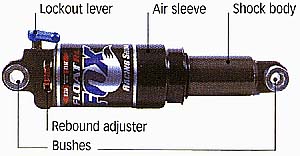
Parts of a rear suspension unit
Lockout lever; Air sleeve; shock body; Rebound adjuster; Bushes.
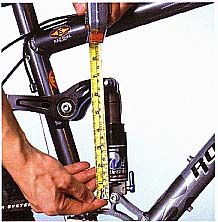
Adjusting the sag
1. Measure the center-to-center distance between the shock-mounting bolts with the bike unloaded.
- Sit on the bike and ask someone to measure this distance again.
- Express the second measurement as a proportion of the first. The figure should be between one-quarter and one-third.
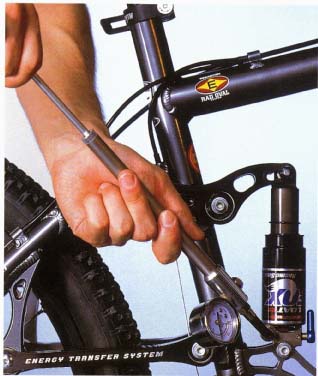
2. Let air out or pump it in as needed on an air/oil shock absorber.
- Take the second measurement again.
- Keep adjusting the air within the air/oil shock absorber until this measurement falls to where you want it within the recommended range.
- Increase or decrease the preload on a coil/oil shock absorber to achieve the measurement you want. Remember that the recommended range is only a guide.
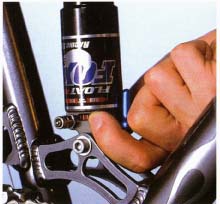
3. Accustom yourself to riding a suspension bike before fine-tuning the damping speed with the rebound adjuster—if your bike has one.
- Turn the adjuster on an air/oil shock absorber—follow the instructions on the shock to find out which way to turn.
- Do not set it too fast because this can upset the handling of the bike.
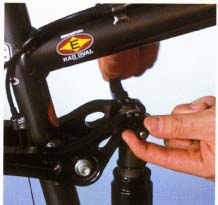
4. Undo the quick-release lever (if your system has one) to alter the total amount of travel available, which can range from 3 1/2 inch to 4 1/2 inch (87mm to 112mm). This adjustment can be particularly useful at the start of a descent where increased speeds will mean bigger impacts from any obstacles you encounter on the trail. The increased travel will help to absorb them.
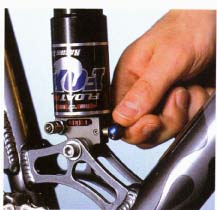
5. Use the lockout mechanism, if your bike has one, to stop the action of the suspension.
- (On the unit shown above, the small blue lever switches it on or off.) Across flat ground, up a smooth climb, or on the road, the lockout temporarily prevents the suspension from absorbing the power you put into pedaling.